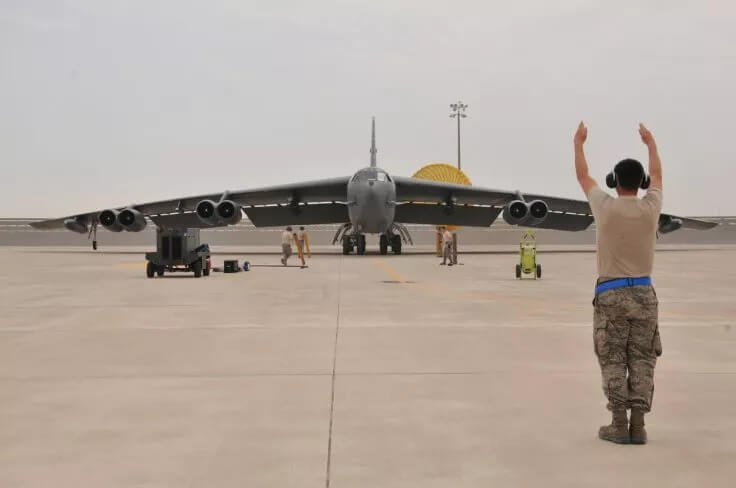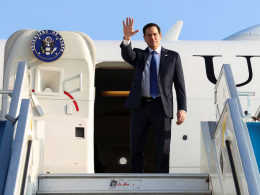On Tuesday, new reports revealed that the United States Air Force hopes to shrink its presence in the Middle East by 2024, focusing more of its resources on countering China in the Indo-Pacific. The latest development comes as the Islamic Republic of Iran recently signed a normalization agreement with one of America's closest Gulf-Arab allies, Saudi Arabia, brokered by the Chinese Communist government.
According to reports, Air Force Service officials on Monday asked Congress for $7 billion to fund trimmed-down military operations in the Middle East and Southwest Asia, following requests by the Biden administration's 2024 budget, which is $1.6 billion less than it received for missions last year.
Such a move would take money away from efforts like Operation Inherent Resolve, an ongoing military effort in Syria and Iraq against the Islamic State (ISIS), and Operation Sentinel, used to monitor Islamic terrorist group activity in Afghanistan.
Officials at the Air Force instead want to increase its troops and infrastructure in places like Guam and the Northern Mariana Islands, which are part of the China , a program established in 2021 to increase the readiness and responsiveness of American forces in the Pacific against China's military actions in the South China sea.
During a briefing on Monday, Kristyn Jones, the Air Force's interim undersecretary, explained that the goal of cutting spending on the Air Force's continuing wars by 30% over three years is a shift "toward the pacing challenge of China and making sure that we are using our funds most effectively."
American airmen in the Middle East are currently stationed in Qatar, the United Arab Emirates, and Kuwait, which host more than 17,000 U.S. troops.
According to reports, the Pentagon has not decided to change the U.S. Air Force's presence in the Central Command (CENTCOM), which has trained with Arab and Israeli forces to deter the Islamic Republic of Iran and its terrorist proxies.
"Most likely, it would be a combination of a number of different factors that would allow us to marginally reduce our costs in that area," Jones stated.
The $7 billion asked by Air Force Service officials would fund operations and maintenance from combat and military training fights to cyber defense and base servicing, making it a fraction of the $70 billion along with the operations budget that keeps the military service running throughout the world.
According to the Air Force budget documents, $845 million would cover the service's workforce expenses abroad, with several construction projects in Europe costing around $226 million in the downsized plan.
The plan consists of storage for fast-deploying "base-in-a-box" kits in Norway, airfield repair tools at the British Royal Air Force (RAF) Lakenheath and Fairford, munitions storage in Spain, and other planning and material efforts.
The Air Force did not include the European Defense Initiative projects meant to support Ukraine in its war to defend Russia following last year.
Speaking to reporters, Air Force Secretary Frank Kendall noted that the service is looking heavily into mobility, munitions, and electronic warfare as it prepares new approaches to suppress enemy air defenses.
"One of the lessons, I think, in Ukraine is that countering air defenses is really the central thing to be able to do," Kendall said.
"One of the things we have been providing to the Ukrainians is some capability to do that mission with the aircraft that they already have."
The Air Force Secretary explained that other nations like Russia and China have "invested asymmetrically" in "robust air defense systems, both for surface shops and for land-based air defense," he added.
"We are working on a number of things to try to get at that problem."
With the Air Force looking to increase and bolster in the Indo-Pacific instead of the Middle East, it has proposed to put $1.9 billion towards the Pentagon's $9 billion Pacific Deterrence Initiative against China next year.
According to reports, around $450 million of the funds would go to make sure that the Air Force is prepared in the Pacific, allowing it to launch attacks if military installations are destroyed. The funds would also grant airmen flexibility in the field through a military concept called "agile combat employment."
"We are generally trying to expand the target set that potential adversaries are gonna have to worry about," Kendall said in early March.
"We are trying to make the idea of 'agile combat employment' meaningful, and that we really have places where we have prepositioned equipment, in some cases, as well as the other infrastructure we are going to need to operate successfully."
Pentagon documents note that this plan is "a mix of concealment, hardening, pre-positioned essential supplies, tactical mobility, improved expeditionary communications, and both active and passive defenses in addition to expanding the number of bases from which to operate."
The plans by the Air Force would add contractors to the region's mission defense teams, cyber defense troops, and support to local units across the globe. The funds would also generate more F-35A Lightning II fighter jets for the Indo-Pacific and boost the KC-135 Stratotanker.
In 2024, officials expect to see progress toward the Pacific Multi-Domain Training and Experimentation Capability, a digital military network that connects training ranges so troops can practice together.
If the request is approved by Congress, officials say that the Air Force could build a brand new Flightline for strategic bombers at the Royal Australian Air Force (RAAF) base in Australia. In Asia, military projects at the Kadena Air Base in Japan would allow work on maintenance hangers for search and rescue operations.
Related Story: Pentagon Unveils New Nuclear Stealth Bomber as Tensions with China Grow










